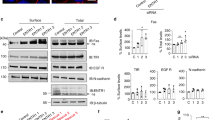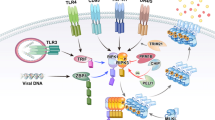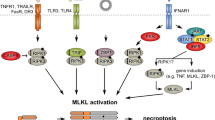Abstract
The death receptors tumour-necrosis factor receptor-1 (TNFR1) and CD95 (also known as FAS and APO-1) transduce signals that promote cell death by apoptosis. However, these receptors are also capable of inducing anti-apoptotic signals through the activation of the transcription factor nuclear factor-κB (NF-κB) or through activation of the proliferative mitogen-activated protein kinase (MAPK) cascade. Recent findings reveal a role for receptor internalization and endosomal trafficking in selectively transmitting the signals that lead either to apoptosis or to the survival of the cell.
This is a preview of subscription content, access via your institution
Access options
Subscribe to this journal
Receive 12 print issues and online access
$189.00 per year
only $15.75 per issue
Buy this article
- Purchase on Springer Link
- Instant access to full article PDF
Prices may be subject to local taxes which are calculated during checkout


Similar content being viewed by others
References
McPherson, P. S., Kay, B. K. & Hussain, N. K. Signaling on the endocytic pathway. Traffic 2001. 2, 375–384 (2001).
Sorkin, A. & Von Zastrow, M. Signal transduction and endocytosis: close encounters of many kinds. Nature Rev. Mol. Cell Biol. 3, 600–614 (2002).
Teis, D. & Huber, L. A. The odd couple: signal transduction and endocytosis. Cell Mol. Life Sci. 60, 2020–2033 (2003).
Miaczynska, M., Pelkmans, L. & Zerial, M. Not just a sink: endosomes in control of signal transduction. Curr. Opin. Cell Biol. 16, 400–406 (2004).
Le Roy, C. & Wrana, J. L. Clathrin- and non-clathrin-mediated endocytic regulation of cell signalling. Nature Rev. Mol. Cell Biol. 6, 112–126 (2005).
Mayor, S. & Pagano, R. E. Pathways of clathrin-independent endocytosis. Nature Rev. Mol. Cell Biol. 8, 603–612 (2007).
Hsu, H., Shu, H. B., Pan, M. G. & Goeddel, D. V. TRADD–TRAF2 and TRADD–FADD interactions define two distinct TNF receptor 1 signal transduction pathways. Cell 84, 299–308 (1996).
Kischkel, F. C. et al. Cytotoxicity-dependent APO-1 (Fas/CD95)-associated proteins form a death-inducing signaling complex (DISC) with the receptor. EMBO J. 14, 5579–5588 (1995).
Scaffidi, C., Medema, J. P., Krammer, P. H. & Peter, M. E. FLICE is predominantly expressed as two functionally active isoforms, caspase-8/a and caspase-8/b. J. Biol. Chem. 272, 26953–26958 (1997).
Medema, J. P. et al. FLICE is activated by association with the CD95 death-inducing signaling complex (DISC). EMBO J. 16, 2794–2804 (1997).
Yeh, W. C. et al. Early lethality, functional NF-κB activation, and increased sensitivity to TNF-induced cell death in TRAF2-deficient mice. Immunity 7, 715–725 (1997).
Lee, S. Y. et al. TRAF2 is essential for JNK but not NF-κB activation and regulates lymphocyte proliferation and survival. Immunity 7, 703–713 (1997).
Grech, A. P. et al. TRAF2 differentially regulates the canonical and noncanonical pathways of NF-κB activation in mature B cells. Immunity 21, 629–642 (2004).
Harper, N., Hughes, M., MacFarlane, M. & Cohen, G. M. Fas-associated death domain protein and caspase-8 are not recruited to the tumor necrosis factor receptor 1 signaling complex during tumor necrosis factor-induced apoptosis. J. Biol. Chem. 278, 25534–25541 (2003).
Micheau, O. & Tschopp, J. Induction of TNF receptor I-mediated apoptosis via two sequential signaling complexes. Cell 114, 181–190 (2003).
Locksley, R. M., Killeen, N. & Lenardo, M. J. The TNF and TNF receptor superfamilies: integrating mammalian biology. Cell 104, 487–501 (2001).
Wajant, H., Pfizenmaier, K. & Scheurich, P. Tumor necrosis factor signaling. Cell Death. Differ. 10, 45–65 (2003).
Mosselmans, R., Hepburn, A., Dumont, J. E., Fiers, W. & Galand, P. Endocytic pathway of recombinant murine tumor necrosis factor in L-929 cells. J. Immunol. 141, 3096–3100 (1988).
Bradley, J. R., Johnson, D. R. & Pober, J. S. Four different classes of inhibitors of receptor-mediated endocytosis decrease tumor necrosis factor-induced gene expression in human endothelial cells. J. Immunol. 150, 5544–5555 (1993).
Schütze, S. et al. Inhibition of receptor internalization by monodansylcadaverine selectively blocks p55 tumor necrosis factor receptor death domain signaling. J. Biol. Chem. 274, 10203–10212 (1999).
Schneider-Brachert, W. et al. Compartmentalization of TNF receptor 1 signaling: internalized TNF receptosomes as death signaling vesicles. Immunity 21, 415–428 (2004).
Schneider-Brachert, W. et al. Inhibition of TNF receptor 1 internalization by adenovirus 14.7K as a novel immune escape mechanism. J. Clin. Invest. 116, 2901–2913 (2006).
Kull, F. C. Jr. & Cuatrecasas, P. Possible requirement of internalization in the mechanism of in vitro cytotoxicity in tumor necrosis serum. Cancer Res. 41, 4885–4890 (1981).
Watanabe, N. et al. Continuous internalization of tumor necrosis factor receptors in a human myosarcoma cell line. J. Biol. Chem. 263, 10262–10266 (1988).
Pastorino, J. G. et al. The cytotoxicity of tumor necrosis factor depends on induction of the mitochondrial permeability transition. J. Biol. Chem. 271, 29792–29798 (1996).
Wiegmann, K., Schütze, S., Machleidt, T., Witte, D. & Krönke, M. Functional dichotomy of neutral and acidic sphingomyelinases in tumor necrosis factor signaling. Cell 78, 1005–1015 (1994).
Lin, T. et al. Role of acidic sphingomyelinase in Fas/CD95-mediated cell death. J. Biol. Chem. 275, 8657–8663 (2000).
Morales, A., Lee, H., Goni, F. M., Kolesnick, R. & Fernandez-Checa, J. C. Sphingolipids and cell death. Apoptosis 12, 923–939 (2007).
Manthey, C. L. & Schuchman, E. H. Acid sphingomyelinase-derived ceramide is not required for inflammatory cytokine signalling in murine macrophages. Cytokine 10, 654–661 (1998).
Nix, M. & Stoffel, W. Perturbation of membrane microdomains reduces mitogenic signaling and increases susceptibility to apoptosis after T cell receptor stimulation. Cell Death. Differ. 7, 413–424 (2000).
Adam, D., Wiegmann, K., Adam-Klages, S., Ruff, A. & Krönke, M. A novel cytoplasmic domain of the p55 tumor necrosis factor receptor initiates the neutral sphingomyelinase pathway. J. Biol. Chem. 271, 14617–14622 (1996).
Adam-Klages, S. et al. FAN, a novel WD-repeat protein, couples the p55 TNF-receptor to neutral sphingomyelinase. Cell 86, 937–947 (1996).
Boone, E., Vandevoorde, V., De Wilde, G. & Haegeman, G. Activation of p42/p44 mitogen-activated protein kinases (MAPK) and p38 MAPK by tumor necrosis factor (TNF) is mediated through the death domain of the 55-kDa TNF receptor. FEBS Lett. 441, 275–280 (1998).
Schwandner, R., Wiegmann, K., Bernardo, K., Kreder, D. & Krönke, M. TNF receptor death domain-associated proteins TRADD and FADD signal activation of acid sphingomyelinase. J. Biol. Chem. 273, 5916–5922 (1998).
Wiegmann, K. et al. Requirement of FADD for tumor necrosis factor-induced activation of acid sphingomyelinase. J. Biol. Chem. 274, 5267–5270 (1999).
Monney, L. et al. Role of an acidic compartment in tumor-necrosis-factor-α-induced production of ceramide, activation of caspase-3 and apoptosis. Eur. J. Biochem. 251, 295–303 (1998).
Garcia-Ruiz, C. et al. Defective TNF-α-mediated hepatocellular apoptosis and liver damage in acidic sphingomyelinase knockout mice. J. Clin. Invest. 111, 197–208 (2003).
Heinrich, M. et al. Cathepsin D links TNF-induced acid sphingomyelinase to Bid-mediated caspase-9 and -3 activation. Cell Death. Differ. 11, 550–563 (2004).
Cifone, M. G. et al. Apoptotic signaling through CD95 (Fas/Apo-1) activates an acidic sphingomyelinase. J. Exp. Med. 180, 1547–1552 (1994).
Herr, I., Wilhelm, D., Bohler, T., Angel, P. & Debatin, K. M. Activation of CD95 (APO-1/Fas) signaling by ceramide mediates cancer therapy-induced apoptosis. EMBO J. 16, 6200–6208 (1997).
De Maria, R., Rippo, M. R., Schuchman, E. H. & Testi, R. Acidic sphingomyelinase (ASM) is necessary for Fas-induced GD3 ganglioside accumulation and efficient apoptosis of lymphoid cells. J. Exp. Med. 187, 897–902 (1998).
Brenner, B. et al. Fas/CD95/Apo-I activates the acidic sphingomyelinase via caspases. Cell Death. Differ. 5, 29–37 (1998).
Dumitru, C. A. & Gulbins, E. TRAIL activates acid sphingomyelinase via a redox mechanism and releases ceramide to trigger apoptosis. Oncogene. 25, 5612–5625 (2006).
Thon, L., Mathieu, S., Kabelitz, D. & Adam, D. The murine TRAIL receptor signals caspase-independent cell death through ceramide. Exp. Cell Res. 312, 3808–3821 (2006).
Woo, C. H. et al. Inhibition of receptor internalization attenuates the TNFα-induced ROS generation in non-phagocytic cells. Biochem. Biophys. Res. Commun. 351, 972–978 (2006).
Heinrich, M. et al. Cathepsin D targeted by acid sphingomyelinase-derived ceramide. EMBO J. 18, 5252–5263 (1999).
Chen, G. & Goeddel, D. V. TNF-R1 signaling: a beautiful pathway. Science 296, 1634–1635 (2002).
Neumeyer, J. et al. TNF-receptor I defective in internalization allows for cell death through activation of neutral sphingomyelinase. Exp. Cell Res. 312, 2142–2153 (2006).
Schütze, S. & Tchikov, V. in Programmed Cell Death Part A Volume 442 Ch. 5 (eds Khosravi-Far, R. et al.) (Academic Press, in the press).
Stanger, B. Z., Leder, P., Lee, T. H., Kim, E. & Seed, B. RIP: a novel protein containing a death domain that interacts with Fas/APO-1 (CD95) in yeast and causes cell death. Cell 81, 513–523 (1995).
Hsu, H., Huang, J., Shu, H. B., Baichwal, V. & Goeddel, D. V. TNF-dependent recruitment of the protein kinase RIP to the TNF receptor-1 signaling complex. Immunity 4, 387–396 (1996).
Zheng, L. et al. Competitive control of independent programs of tumor necrosis factor receptor-induced cell death by TRADD and RIP1. Mol. Cell. Biol. 26, 3505–3513 (2006).
Jin, Z. & El Deiry, W. S. Distinct signaling pathways in TRAIL- versus tumor necrosis factor-induced apoptosis. Mol. Cell. Biol. 26, 8136–8148 (2006).
Kelliher, M. A. et al. The death domain kinase RIP mediates the TNF-induced NF-κB signal. Immunity 8, 297–303 (1998).
Devin, A. et al. The distinct roles of TRAF2 and RIP in IKK activation by TNF-R1: TRAF2 recruits IKK to TNF-R1 while RIP mediates IKK activation. Immunity 12, 419–429 (2000).
Liao, W. et al. CARP-2 is an endosome-associated ubiquitin protein ligase for RIP and regulates TNF-induced NF-B activation. Current Biology 18, 641–649 (2008).
Li-Weber, M. & Krammer, P. H. Function and regulation of the CD95 (APO-1/Fas) ligand in the immune system. Semin. Immunol. 15, 145–157 (2003).
Peter, M. E. et al. The CD95 receptor: apoptosis revisited. Cell 129, 447–450 (2007).
Algeciras-Schimnich, A. et al. Molecular ordering of the initial signaling events of CD95. Mol. Cell. Biol. 22, 207–220 (2002).
Feig, C., Tchikov, V., Schütze, S. & Peter, M. E. Palmitoylation of CD95 facilitates formation of SDS-stable receptor aggregates that initiate apoptosis signaling. EMBO J. 26, 221–231 (2007).
Siegel, R. M. et al. SPOTS: signaling protein oligomeric transduction structures are early mediators of death receptor-induced apoptosis at the plasma membrane. J. Cell Biol. 167, 735–744 (2004).
Lee, K. H. et al. The role of receptor internalization in CD95 signaling. EMBO J. 24, 1009–1023 (2006).
Eramo, A. et al. CD95 death-inducing signaling complex formation and internalization occur in lipid rafts of type I and type II cells. Eur. J. Immunol. 34, 1930–1940 (2004).
Chakrabandhu, K. et al. Palmitoylation is required for efficient Fas cell death signaling. EMBO J. 26, 209–220 (2007).
Parlato, S. et al. CD95 (APO-1/Fas) linkage to the actin cytoskeleton through ezrin in human T lymphocytes: a novel regulatory mechanism of the CD95 apoptotic pathway. EMBO J. 19, 5123–5134 (2000).
Koncz, G., Kerekes, K., Chakrabandhu, K. & Hueber, A. O. Regulating Vav1 phosphorylation by the SHP-1 tyrosine phosphatase is a fine-tuning mechanism for the negative regulation of DISC formation and Fas-mediated cell death signaling. Cell Death. Differ. 15, 494–503 (2007).
Barnhart, B. C. et al. CD95 ligand induces motility and invasiveness of apoptosis-resistant tumor cells. EMBO J. 23, 3175–3185 (2004).
Ahn, J. H. et al. Non-apoptotic signaling pathways activated by soluble Fas ligand in serum-starved human fibroblasts. Mitogen-activated protein kinases and NF-κB-dependent gene expression. J. Biol. Chem. 276, 47100–47106 (2001).
Kataoka, T. et al. The caspase-8 inhibitor FLIP promotes activation of NF-κB and Erk signaling pathways. Curr. Biol. 10, 640–648 (2000).
Golks, A., Brenner, D., Krammer, P. H. & Lavrik, I. N. The c-FLIP-NH2 terminus (p22-FLIP) induces NF-κB activation. J. Exp. Med. 203, 1295–1305 (2006).
Smotrys, J. E. & Linder, M. E. Palmitoylation of intracellular signaling proteins: regulation and function. Annu. Rev. Biochem. 73, 559–587 (2004).
Austin, C. D. et al. Death-receptor activation halts clathrin-dependent endocytosis. Proc. Natl Acad. Sci. USA. 103, 10283–10288 (2006).
Kohlhaas, S. L., Craxton, A., Sun, X. M., Pinkoski, M. J. & Cohen, G. M. Receptor-mediated endocytosis is not required for TRAIL-induced apoptosis. J. Biol. Chem. 282, 12831–12841 (2007).
Acknowledgements
Our work was supported by grants from the Deutsche Forschungsgemeinschaft (DFG) SCHU 733/7-1, SCHU733/8-1, SCHU733/9-1and SFB 415, project A11 given to S.S. and FOR 876, TP1 given to W.S.-B.
Author information
Authors and Affiliations
Corresponding author
Related links
Rights and permissions
About this article
Cite this article
Schütze, S., Tchikov, V. & Schneider-Brachert, W. Regulation of TNFR1 and CD95 signalling by receptor compartmentalization. Nat Rev Mol Cell Biol 9, 655–662 (2008). https://doi.org/10.1038/nrm2430
Published:
Issue Date:
DOI: https://doi.org/10.1038/nrm2430



